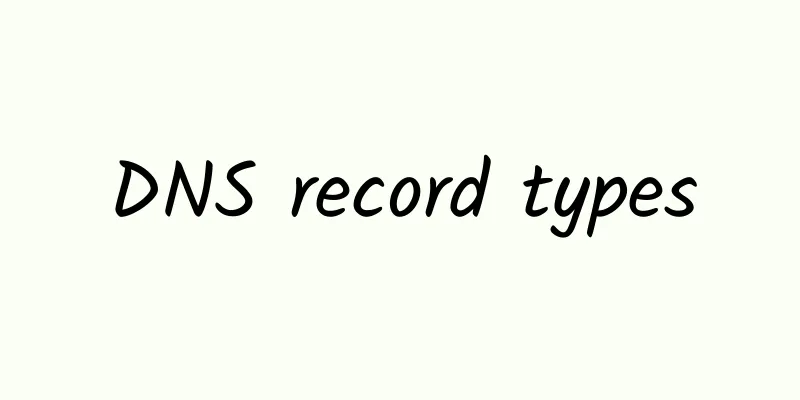DNS record types

|
This article is reprinted from the WeChat public account "Xiaocai Learns Programming", written by fasionchan. Please contact Xiaocai Learns Programming public account for reprinting this article. After the previous study, we have initially grasped the basic principles of the domain name system. We know that a domain name can be associated with a specified IP address, thus acting as an alias for the IP address. When we access network services through domain names, the domain name system will help us resolve the domain name into the corresponding IP address. So, can domain names only be associated with IP addresses? Actually, not really. In addition to IP addresses, domain names can also be associated with other types of information. In fact, a domain name and the information associated with it constitute a DNS record. A DNS record can be understood as a key-value pair:
In addition to IP addresses, DNS record values can also be IPv6 addresses, aliases, text, etc. Based on this, DNS records can be divided into several different types, including:
The record type is the type of the problem record and resource record in the DNS message. A RecordA record, which represents the IP address of a host, is the most common type of DNS record.
AAAA RecordAAAA record, which indicates the IPv6 address of a host, is similar to A record. The length of an IP address is 4 bytes, while the length of an IPv6 address is 16 bytes, which is the origin of the AAAA record. With the deployment of IPv6, AAAA records are becoming more commonly used. The dig command queries A records by default. If you want to query AAAA records, you must specify it through command line parameters:
CNAME RecordCNAME record, which indicates the canonical name of an alias. A domain name can be aliased. For example, webserver.fasionchan.com can be aliased, such as network.fasionchan.com. In this way, we call the former the authoritative name of the latter, and the CNAME record stores the authoritative name. When querying the alias network.fasionchan.com, if the DNS server returns a CNAME record, we need to further query the authoritative name to get the final result. Of course, most DNS cache servers will automatically do this for us. So, why does a domain name need an alias? What are the typical application scenarios of CNAME records? Suppose I have a web server with multiple sites deployed on it:
I can apply for a domain name webserver.fasionchan.com, point it to the web server through the A record; then configure CNAME records for several column domain names, pointing to webserver.fasionchan.com: This has an advantage: if I adjust the web server and migrate it to another host, I only need to change the domain name webserver.fasionchan.com, and the other column domain names do not need to be adjusted. My personal website fasionchan.com is deployed on Alibaba Cloud CDN, and the domain name is also pointed to an Alibaba Cloud domain name through a CNAME record. Otherwise, as long as Alibaba Cloud CDN is adjusted, I have to change the domain name! This will definitely be a nightmare! MX RecordsMX record, which stands for mail exchange service, that is, mail server. MX is the abbreviation of Mail eXchange. Email can be said to be the earliest and most widely used application on the Internet. When we send an email, the client needs to find the address of the email server according to its email account and communicate with it through the SMTP protocol. Each email vendor has its own domain name. By querying the MX record of the domain name, you can find the address of the email server. Take QQ mailbox as an example, its domain name is qq.com. We execute the dig command to query the MX record of qq.com:
It can be seen that QQ Mail has a total of 3 mail exchange services, namely:
We can select one, for example, mx3.qq.com. Its IP address is 14.215.140.20. Connect to it through SMTP protocol, and after the authentication is completed, you can send and receive emails normally. After reading this, you may have a question: Can't A record also be used to find the mail server based on the domain name? Indeed, the A record is theoretically capable of doing this. However, in the early days of the Internet, email was a heavyweight application. It is not surprising that the pioneers of the Internet designed the MX record specifically for it. In fact, Tencent has more than just QQ Mail, there is also Tencent.com. Since the mail service has its own MX record, Tencent.com can use the A record. In this way, both can use the same domain name qq.com: When the browser accesses Tencent.com, it can query the A record of qq.com and get the server address. We can execute the dig command to simulate it:
NS RecordNS record stores the authoritative DNS server responsible for domain resolution, and the record value is the domain name of the DNS server. Take my domain name fasionchan.com as an example. It is resolved on Tencent Cloud dnspod. After I register the domain name, I need to configure the NS record to point to the dnspod server. This NS record will eventually be synchronized to the .com top-level domain name server. As a result, when the client initiates iterative resolution, the com domain name server knows that it should look for dnspod to query the domain name. If I want to transfer my domain name to Alibaba Cloud for resolution, I only need to find my domain name registrar and modify the NS record to point to Alibaba Cloud's DNS server. Once everything is ready, I can manage my domain name on Alibaba Cloud. I can also give the subdomain lumy.fasionchan.com to my friend Lumy, as long as I add the NS record for lumy.fasionchan.com on dnspod, pointing to the DNS server of Lumy's choice. After that, Lumy can manage the domain on his own DNS service. When a client iteratively queries the subdomain lumy.fasionchan.com, dnspod will tell the client to query Lumy's DNS server based on the NS record (assuming that Lumy manages the subdomain on Alibaba Cloud): It can be seen that NS records play a very important role in DNS iterative query. The upper-level DNS server finds the lower-level DNS server through the NS record until the domain name query is completed. In theory, the root domain also needs NS records to point to the 13 root domain name servers in the world. Where are the NS records of the root domain maintained? Since the root server rarely changes, it can be specified through configuration. The client can query the root domain NS record, and the DNS cache server will answer according to its own configuration:
TXT RecordTXT records are used to store some text information, which can be used as configuration, but is not very common. Let's take an example:
Many cloud platforms use TXT records to verify domain ownership: first let the domain owner configure a special TXT record, and then query the record to see if the result matches. |
<<: Let’s listen to what 5G R18 is talking about?
Recommend
Aruba Named a Leader in Gartner Magic Quadrant for Wired and Wireless LAN Access Infrastructure
November 17, 2017, Beijing - Recently, Aruba, a l...
The Ministry of Industry and Information Technology announced the ten major events of 2017. Mobile data charges dropped to 26 yuan/GB.
Recently, the Ministry of Industry and Informatio...
Microsoft redesigns the calling interface in Teams
[[356857]] Microsoft Corp. has reportedly begun r...
VirMach: supports monthly payment of KVM architecture starting from $1.25/month, supports Alipay, and has 11 computer rooms to choose from
It has been a long time since I shared informatio...
BuyVM: AMD Ryzen KVM small amount of restocking starting at $3.5/month, 1Gbps unlimited traffic, Las Vegas/Luxembourg, etc.
BuyVM's low-end VPS packages are currently be...
Comparison of new number segment packages of the three major operators: Which one do you prefer?
Since the beginning of 2018, the new number segme...
How does 5G open the door to huge technological advancement for manufacturing companies?
The rollout of 5G is expected to usher in the Fou...
What impact will 5G have on us?
1. First of all, it is clear that fiber optic tra...
Advanced Web Essentials: Network Optimization, Use It to Impress the Interviewer
Preface I've been so busy lately, the app is ...
HostKvm newly launched Russia/Hong Kong high-defense VPS, 50% off for Mid-Autumn Festival
HostKvm has launched new products, this time with...
Aruba Helps Global Operators Seamlessly Extend 5G Cellular Networks to Enterprise Environments with Passpoint-Based Wi-Fi Services
Recently, Aruba, a subsidiary of HPE, announced t...
When 5G meets edge cloud, it is the fundamental reason why 5G changes the world
On June 6, 2019, a very auspicious day, the Minis...
Musk said: Satellite Internet will be publicly tested within 6 months! It will not be 6G that will subvert 5G
This article is reprinted with permission from AI...
The Ministry of Industry and Information Technology issued a notice, and the three major operators had no choice but to accept it. Users who have not yet switched to 5G are blessed
The 5G era is coming. What should 4G users do? On...
In the win-win multi-cloud era, Juniper Networks helps enterprises achieve digital transformation
In July this year, Gartner released the 2019 Data...









